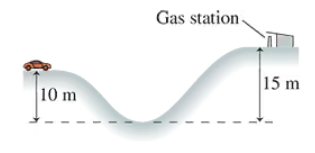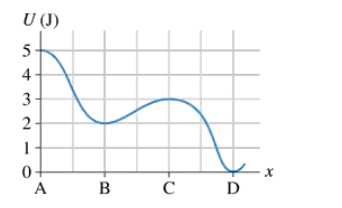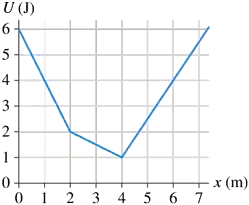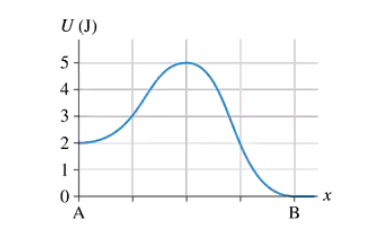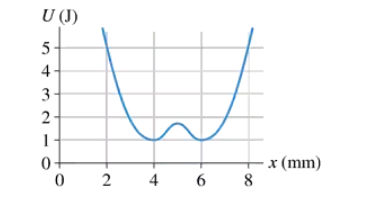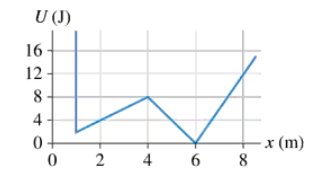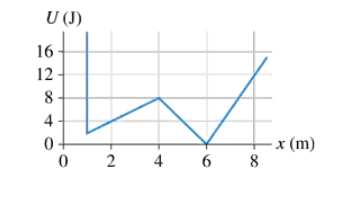 Back
BackProblem 1a
A system of two objects has and . How much work is done by interaction forces?
Problem 2
A system consists of interacting objects A and B, each exerting a constant 3.0 N pull on the other. What is ∆U for the system if A moves 1.0 m toward B while B moves 2.0 m toward A?
Problem 4
The free-fall acceleration on a large asteroid, in the vacuum of space, is 0.15 m/s2. A spacecraft hovering 500 m above the surface drops a 25 kg payload wrapped in a padded jacket. What is the payload's impact speed?
Problem 6
A 55 kg skateboarder wants to just make it to the upper edge of a 'quarter pipe,' a track that is one-quarter of a circle with a radius of 3.0 m. What speed does he need at the bottom?
Problem 9
A 20 kg child is on a swing that hangs from 3.0-m-long chains. What is her maximum speed if she swings out to a 45° angle?
- The spring in FIGURE EX10.21a is compressed by 10 cm. It launches a block across a frictionless surface at 0.50 m/s. The two springs in Figure EX10.21b are identical to the spring of Figure EX10.21a. They are compressed by the same 10 cm and launch the same block. What is the block's speed now?
Problem 10
Problem 10a
A pendulum is made by tying a 500 g ball to a 75-cm-long string. The pendulum is pulled 30° to one side, then released. What is the ball's speed at the lowest point of its trajectory?
Problem 11
A 1500 kg car traveling at 10 m/s suddenly runs out of gas while approaching the valley shown in FIGURE EX10.11. The alert driver immediately puts the car in neutral so that it will roll. What will be the car's speed as it coasts into the gas station on the other side of the valley? Ignore rolling friction.
Problem 12
The maximum energy a bone can absorb without breaking is surprisingly small. Experimental data show that a leg bone of a healthy, 60 kg human can absorb about 200 J. From what maximum height could a 60 kg person jump and land rigidly upright on both feet without breaking his legs? Assume that all energy is absorbed by the leg bones in a rigid landing.
Problem 14a
In a hydroelectric dam, water falls 25 m and then spins a turbine to generate electricity. What is of 1.0 kg of water?
Problem 14b
In a hydroelectric dam, water falls 25 m and then spins a turbine to generate electricity. Suppose the dam is 80% efficient at converting the water's potential energy to electrical energy. How many kilograms of water must pass through the turbines each second to generate 50 MW of electricity? This is a typical value for a small hydroelectric dam.
Problem 17
A stretched spring stores 2.0 J of energy. How much energy will be stored if the spring is stretched three times as far?
Problem 19
As a 15,000 kg jet plane lands on an aircraft carrier, its tail hook snags a cable to slow it down. The cable is attached to a spring with spring constant 60,000 N/m. If the spring stretches 30 m to stop the plane, what was the plane's landing speed?
Problem 23
The elastic energy stored in your tendons can contribute up to 35% of your energy needs when running. Sports scientists find that (on average) the knee extensor tendons in sprinters stretch 41 mm while those of nonathletes stretch only 33 mm. The spring constant of the tendon is the same for both groups, 33 N/mm. What is the difference in maximum stored energy between the sprinters and the nonathletes?
Problem 24
FIGURE EX10.24 is the potential-energy diagram for a 500 g particle that is released from rest at A. What are the particle's speeds at B, C, and D?
Problem 25b
FIGURE EX10.25 is the potential-energy diagram for a 20 g particle that is released from rest at x = 1.0 m. What is the particle's maximum speed? At what position does it have this speed?
Problem 26b
In FIGURE EX10.26, What minimum speed does a 100 g particle need at point B to reach point A?
Problem 27
In FIGURE EX10.27, what is the maximum speed of a 2.0 g particle that oscillates between x = 2.0 mm and x = 8.0 mm
Problem 28a
FIGURE EX10.28 shows the potential-energy diagram for a 500 g particle as it moves along the x-axis. Suppose the particle's mechanical energy is 12 J. Where are the particle's turning points?
Problem 29
In FIGURE EX10.28, what is the maximum speed a 200 g particle could have at x = 2.0 m and never reach x = 6.0 m?

